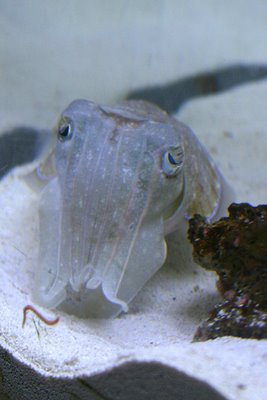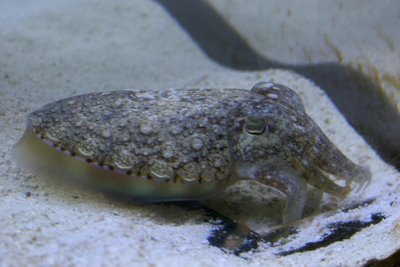I visited the Houston Museum of Natural Science recently. There’s a lot to see there, including the amazing Body Worlds exhibit which shows partially dissected human cadavers in various poses. The cadavers have been plasticized so they don’t smell. That was what brought me there in the first place. It was interesting but I’ve already seen my share of cadavers.
What really got my attention was the Strake Hall of Malacology. I didn’t even know what malacology was, although I was somewhat familiar with some of its members. Malacology is the study of mollusks. The most familiar mollusks are, of course, snails. Or maybe it’s oysters or clams. I suppose that depends on whether you like seafood.
There are over 100,000 species of mollusks and the museum had a fantastic display of their incredibly beautiful shells. With over 100,000 species of mollusks there are a lot of shells to display. The thing that interested me most in the exhibit was a small aquarium housing two very cute mollusks. How can a mollusk be cute? Have you seen a cuttlefish? They are amazing animals. These two were swimming placidly, their eight arms streaming down from between their eyes and their two tentacles holding them stationary. They followed my movement with big, intelligent eyes.
Cuttlefish belong to the group of mollusks known as cephalopods, made up of four groups of animals, the cuttlefish, squid, octopuses and nautiluses. Most people only know cuttlefish from cuttlebone, the calcium supplement provided to pet birds. The cuttlebone is the last remnant of the ancestral shell shared by all mollusks but now only obvious among cephalopods in the nautiluses.
The cuttlebone is not what fascinated me as I stared into the aquarium. What most amazed me was the way the two captives were changing colors. Cephalopods are known as “the chameleons of the sea” but this does not do them justice. Chameleons can display some impressive color changes but they take minutes to accomplish. They are totally outclassed by animals such as these two cuttlefish. They changed colors so fast they were actually flashing. And each was trimmed with a narrow strip of neon purple.
On the wall of the museum was a mural showing a sperm whale battling a giant squid. Giant squid get up to about 45 feet long but at least half of that is in the tentacles and arms. They don’t weight much and will always lose a battle with a sperm whale.
As I watched the two little cuttlefish, I was saddened by the knowledge that they couldn’t be very old. The very oldest of cephalopods, those that live in nearly frozen artic waters, are thought to live up to six years. Most other species live between one and three years. Amazingly this includes even the giant squid and its slightly larger relation, the colossal squid.
Cephalopods are possibly the most intelligent of the invertebrates, animals without backbones. They have been shown to use their incredible color-changing capabilities to communicate with each other. Associated with their chromatic abilities, cephalopods have very good vision and large brains. If it weren’t for their short lives and generally solitary habits, they might someday rule the world! Well, maybe not. The lack of bones and the inability to function on land will probably save us from a cephalopod take-over even if the overcome their other obstacles.
Web information:
http://www.thecephalopodpage.org/
http://www.cephbase.utmb.edu/
 One of the two cuttlefish at the museum.
One of the two cuttlefish at the museum. I believe this is a face everyone can love.
I believe this is a face everyone can love.
The second cuttlefish showing a darker pattern.

3 comments:
palm angels
kyrie 7
off white hoodie
yeezy shoes
bape clothing
kd shoes
yeezy
hermes handbags
bape outlet
bape clothing
off white outlet
supreme new york
hermes outlet
kobe shoes
pg 1
I found it fascinating how quickly cuttlefish can change colors.
Post a Comment